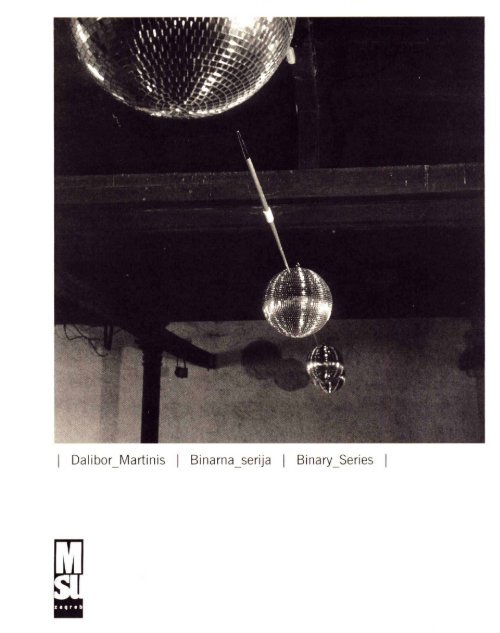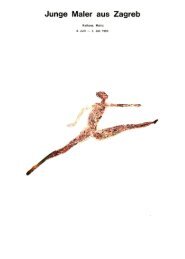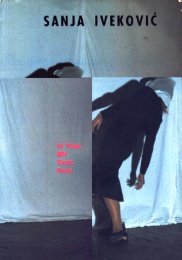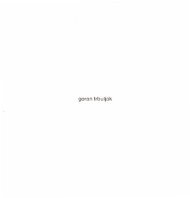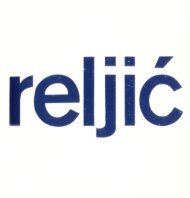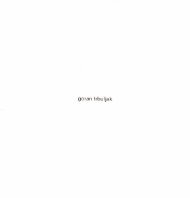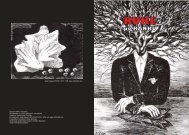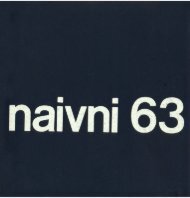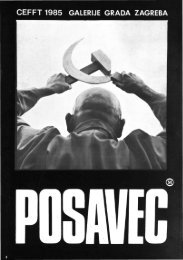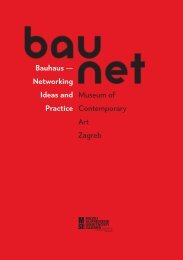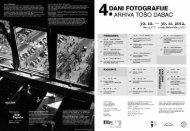Download - Muzej suvremene umjetnosti Zagreb
Download - Muzej suvremene umjetnosti Zagreb
Download - Muzej suvremene umjetnosti Zagreb
You also want an ePaper? Increase the reach of your titles
YUMPU automatically turns print PDFs into web optimized ePapers that Google loves.
Dalibor Martinis Binarna serija Binary_Series
Dalibor Martinis Bi narna _serijaPovodom _izložbe _2 _PorukeIOn _ the_occasion _ot the _exhibition _2_ MessagesParomlin_<strong>Zagreb</strong>_2.1O._10.1O.2001.IKustos_CuratorTihomir_MilovacMuzeL <strong>suvremene</strong> _ umjelnosti_ <strong>Zagreb</strong> IMuseum_of_Contemporary_Arl_<strong>Zagreb</strong>I
Tihomir Milovac I Binarna_serija IMorseovim pismom šifri rana poruka koju su svjetlosnimsignalima iz svojih saksofona odaslali dvojica saksofonistana kraju Martinisovog video filma Dutch Moves (1986.)bio je, danas to možemo reći, nagovještaj, programatski iline, radovima nastalim u protekle tri godine objedinjenihkao Binarna serija. U njima umjetnik koristi matematičkifenomen binarnog sustava pri čemu su sve informacijepretvorene u brojčane nizove sačinjene isključivo od brojeval i O. Zašto baš binarni sustav? Nekoliko je, čini mi se,razloga za to. Prije svega razlog je u sve prisutnijemfenomenu digitaliziranosti koji od osamdesetih godinanaovamo intenzivno zahvaća sve sfere naših života, osobnei društvene, intelektualne i biološke, emocionalne iDutch Moves, 1986. racionalne, perceptivne i kognitivne te postupno mijenjavideo postojeće važeće vrijednosne sustave. Drugi vrlo opravdanrazlog vidim u sferi pragmatičke stvarnosti svijeta, globalnogkao i lokalnog, koji na prijelazu milenija uporno odbija objektivizirati istinu o sebi, aona, sva nas recentna zbivanja upućuju na to, upće nije lijepa. Takvo odbijanje, čini mi se,uzrokuje polarizaciju svijeta, prije svega ekonomsku, i pretpostavka je za nerazumijevanje teposljedično, za sukobe svih vrsta (ideološke, religijske ... J. Stoga danas Martinisove saksofonistemožemo čltati kao ironičnu i ciničnu parafrazu poznate nam biblijske prefiguracijeJerihonskih truba te truba iz Apokalipse i Posljednjeg suda (koliko je poruka saksofonistashvaćena tek će se vidjetil).Dakle, Martinis u novim radovima upozorava na sveprisutno nerazumijevanje, na sveopćuindolenciju, prema Drugome i drugačijem, prisutnu u današnjim društvima bilo da su onarazvijena i demokratska ili to nisu. Upozorava nas posredno na masovnu komunikacijskuhiperaktivnost i na neospornu potrebu zaštite osobnog i drugačijeg. Odlučio se na odašiljanjesvojih, samo njemu poznatih binarno kodiranih poruka, razumljivih onima koji binarne sustavemogu, znaju ili žele dekodirati. Time je zauzeo dvojnu, bivalentnu poziciju. Poziciju3
angažiranosti koju prepoznajemo upravo u sustavnom odašiljanju poruka u javnost i suprotnu,intimističku, autističnu poziciju suspregnutog ja, vidljivu u kriptografskom postupku ispisivanjaporuka.Radovi nastali od 1998. uglavnom su, po načinu kako su izvedeni, instalacije, audio-performansii videa. Instalacije umjetnik postavlja ravnopravno u galerijske i javne gradske prostorekoristeći postojeće zatečene predmete: limena vjedra, palme, automobile, disko kugle,rasvjetna tijela (Labirint, <strong>Zagreb</strong>, 1998., Cairo Message, Kairo 1998., Dnevnik 12.-18.2.1999., <strong>Zagreb</strong>, 1999. Light it Up, NYC, 2000., Parken Verboten, Rosenheim 2000.,Koplja i kugle, <strong>Zagreb</strong>, 2001.). U audio-performansima umjetnik zvoni na crkvenim zvonimačiji različiti tonovi prenose binarno kodiranu poruku (Conference Call, Codroipo, 2000.,News Broadcast, <strong>Zagreb</strong>, 2001., Razgovor, Zadar, 2001.) Seriju video filmova koji prateneke instalacije i performanse u kojima se služi istim postupkom kodiranja poruka Martinisje doveo do perfekcije u video filmu Inside The Maltese Falcon, 2001. nastao re-editiranjempoznatog holivudskog filma Johna Hustona Malteški sokol. U novu verziju upisan je binarnokodirani tekst tako da su O pretvorene u crna polja dok su brojevi l ostatak originalnogfilma. Film stoga treperi praveći tipičnu atmosferu karakterističnu za filmove s početka povijestifilma.Opsesiju kodovima po prvi put značajnije plasira u manifestnom radu Labirint, 1998. naizložbi Brain-Storm u <strong>Muzej</strong>u <strong>suvremene</strong> <strong>umjetnosti</strong> u <strong>Zagreb</strong>u. Digitalno generirani videosimetrično podijeljenog umjetnikovog lica, čije se polutke neovisno okreću lijevo-desno, bioje zapravo prijenosnik njegove dvojbe. Po podu muzeja odvijao se grafički prikaz binarnogprincipa oblikovanog u alternativno kretanje lijevo ili desno.U Dnevniku kojeg je realizirao od 12.-18.2. 1999. godine u prostoru Galerije Proširenihmedija (HDLU), svakodnevno je "pisao" svoj osobni dnevnik. Raspoređivao je lončanicepalmi i notne stalke u binarni niz tvoreći aritmične "kompozicije" naoko tipične za umjetnostdevedesetih godina 20.st. i postupak jukstapozicije, odnosno dovođenje u paralelnu egzistencijuviše predmeta, oblika i značenja kako bi se postigao novi kvalitet. Umjetnikove"poruke" ovdje se nisu krile, kako to obično očekujemo od likovnog djela, u njegovojduhovnoj sferi, u njegovim simboličkim ili formalnim dimenzijama nego u njegovoj fizičnosti.OVdje su "poruke" doslovno i Vidljivo ispisane, međutim čitljive su samo uz primjenu znanjadekodiranja. Stoga se nameće pitanje: "Je li za akceptiranje duhovne dimenzije djela potrebnoznati sadržaj kodirane poruke?" Odgovor bi mogao biti i da i ne. Umjetnik zapravo ne taji4
poruke, medutim malo je onih koji će ih pročitati. A možda nam je dovoljna globalnametafora koju u slučaju radova iz Binarne serije isčitavamo na konceptualnoj razini kaorefleksiju naših vlastitih razmišljanja i osjećanja. (Ipak, trebalo bi se potruditi i dekodiratiporuke. Intelektualne higijene radil)Isti postupak kodiranja umjetnik je primijenio i u nekoliko slijedećih radova. U CairoMessage je pomoću metalnih vjedara ispunjenih vodom iz rijeke Nil i pijeskom iz pustinjeoblikovao instalaciju koja je krila binarno kodiranu poruku. 2000. godine je na glavnom trgumalog njemačkog grada Rosenheima nagurao nekoliko desetina novih crnih i bijelih automobilaVW Golf. Ta neobična automobilska binarna "klavijatura" kojoj je dao naziv "ParkenVerboten" višesrtuko je uzgibala lokalnu zajednicu.Pri realizaciji ovih radova Martinis se uglavnom služio zatečenim predmetima proizašlim izspecifičnosti socio-kulturnog konteksta sredine u kojoj su radovi realizirani. Ta je činjenica sjedne strane olakšala i ubrzala kontakt s publikom, a s druge, stvorila prijeko potrebnunedoumicu na koju umjetnik i računa: poznata i bliska značenja u neočekivanim okolnostima.Sve što će se dogoditi nakon "ispisivanja" poruka ovisi o publici, njenoj potrebi i pristankuna kreativnu igru i otkrivanje intrige. U najnovijem radu Kugle i koplja po prvi put suupotrebljeni predmeti, disco kugle i atletičarska koplja, izvan svog prirodnog konteksta.Ovdje je njihov oblik vrlo vjerna zamjena za grafičke simbole točke i crte Morseove abecede.Izvedbeno drugačija grupa su audio-performansi. Započeo ih je performansom ConferenceCall 2000. godine u talijanskoj regiji Friuli poznatoj po tradiciji crkvenih zvona, zvonika izvonara. U nekoliko je gradova s crkvenih zvonika zvonjenja kodirana poruka čija se binarnastruktura l i O u fizičkom smislu ostvarila kroz tonsku razliku dva zvona. Nastavio je sa performansomNews Broadcast izvedenim u <strong>Zagreb</strong>u 2001. na zvoniku crkve Sv. Marka iRazgovor, 2001. realiziran sa zvonika crkve benediktinskog samostana i zvonika crkve Sv.Stošije u Zadru. Zvučna dimenzija ovih radova te njihova vremenska ograničenost neminovnonas navode na usporedbu s glazbenim djelima. Medutim, Martinisu nije bila namjerastvoriti glazbeno djelo koliko god bi ta dvotonska kompozicija mogla zvučati začudno.Takoder, nije mu previše bila važna niti činjenica da je ovim performansima narušio crkvenupraksu sazivanja vjernika na liturgijski obred budući je njegova "zbunjujuća zvonjava" izvandogovorenog kodeksa komunikacije crkve i vjernika. Martinis je time pokazao da je posvenezainteresiran za poigravanje sa ideološkim pitanjima vezanim uz crkvu. Rekao bih da sekod ovih radova prije svega radi o rasnom umjetničkom postupku izmicanju iz stereotipa5
umjetničkog govora pri čemu je u mediju crkvenih zvona pronašao dovoljno melankolične"fiktivne stvarnosti" koju je uobličio u jaku metaforu današnjice: nerazumijevanje.Ako bi smo seriju novih radova pokušali sagledati u kontekstu ukupnog Martinisovog radatada primjećujemo da je gotovo neprimjetno, bez vidljivih rezova i obrata, rekli bismo "uhodu", u proteklih tri godine unio u svoj umjetnički rad elemente koje nismo, barem ne takoizdvojeno i ogoljelo, susretali u njegovim dosadašnjim radovima. Zapravo se radi o konceptualnostrukturalističkom postupku izoliranja primarnih elemenata koji čine osnovu njegovogdosadašnjeg vizualno-komunikacijskog jezika u mnogim poznatim nam radova. Martinis jeodlučio radikalizirati postupak predočenja svoje poruke i pretvorio ju je u komunikaciju samulišenu nepotrebnih narativnih i likovnih primjesa i pomagala.Takvom postupku strukturiranja djela s "čistim" elementima bio je donekle blizak usedamdesetima iako se tada više bavio analizom medija videa kao sasvim novog i neistraženogmedija. No, i tada kao i danas to nije bila analiza koja rezultira formalističkim djelima.Već je tada, u vrijeme kada je većina umjetnika bila fascinirana mogućnostima videa,dovodio u ironijski odnos visoku tehnologiju tog novog medija sa svakodnevnim tehnološkimbanalnostima. Ti su mu rani video radovi odisali sadržajnom duhovitošću i vizualnomzačudnošću. Na primjer, u video radu Video imunitet (1976.) zamijenio je tuš u kupaonicisa aktivnom video kamerom i prijetvorno se "tuširao" u video slici što nam video snimka ipokazuje.Treba svakako imati na umu da je Martinis uz Sanju Iveković pionir video <strong>umjetnosti</strong> u naste da su njihovi prvi zajednički video radovi, nastali u prvoj polovici sedamdesetih godina,dijelili početna iskustva video eksperimenata drugih, tada također pionira videa od BruceaNeumana, Vite Acconcia do Nam Jun Paika. Umjetničku karijeru započeo je u duhu krajašezdesetih godina sa minimalističkim prostornim ambijentima (Model N&Z, 1969.) kojimavrlo brzo dodaje četvrtu dimenziju, vrijeme. Nalazimo ga u svjetlosnoj instalaciji Četiri trokutaiz 1971. gdje se paljenjem i gašenjem fluorescentnih cijevi ritmički izmjenjuju svjetlosnesekvence i tako uvodi vrijeme trajanja kao nedjeljivi element djela. Formalno-analitički gledajućiti su rani radovi nastali, s jedene strane pod direktnim utjecajem zbivanja oko medunarodnogpokreta Novih Tendencija koje su šezdesetih godina u zagrebačkoj Galeriji <strong>suvremene</strong><strong>umjetnosti</strong> afirmirale istraživanja na području vizualnih komunikacija u kombinaciji s novimtehnologijama, a s druge pak pod utjecajem minimalizma. Tada zapravo i započinje njegovotraganja za novim (video) medijem s kojim će razviti svoj interes za propitivanje stvarnog i
fiktivnog, fizičkog i metafizičkog, tih graničnih fenomena što će mu pomoći u ostvarivanjupredpostavke o snažnijem prožimanju <strong>umjetnosti</strong> i stvarnost.u gotovo cjelokupnomMartinisovom opusu fenomenkomunikacije zauzima značajnomjesto. Već činjenica da je u svojimprvim video radovima kao štoje TV Timer iz 1973. (u suradnjisa Sanjom Iveković) kritički tretiraoteleviziju i manipulativna svojstvatog medija kao najdominantnijegglobalnog medija masovne komunikacije,govori nam u prilog da senajnovija serija radova upravotemom komunikacije i komuniciranjaImage is Virus, 1983.donekle naslanja i na periodvideopočetnih istraživanja video medija.Tako u znamenitom video raduImage is Virus (1983.) Martinis postavlja pitanje o opstojnosti elektronskih slike, njenihinformativnih, estetskih, ikonografskih, simboličkih i prije svega komunikativnih vrijednosti ukontekstu hiperprodukcije i distribucije slika koju omogućava upravo medij televizije kaonajagresivniji medij današnjice. Zato taj video, strukturiran kao ikonoklastička hiperprodukcijaslika poništava važeći modernistički pojam slike kao formalno estetiziranog prijenosnikainformacije.Martinis je u novim radovima napustio "barokno-maniristički" postupak "nadograđivanja"bogatom vizualnošću koju nalazimo u mnogim radovima s kraja osamdesetih i udevedesetih godina. Tada su mu djela reprezentirala maštovito ispričane opsesije i priče"upakirane" često u sfumatnu ovojnicu koja je nejasno dijelila granicu stvarnosti i fikcije.Sjetimo se samo kompleksnog i zagonetnog djela Pogled na drugi pogled, 1986. ili duhoviteigre sa slavnim osobama 20. stoljeća u Napokon večera, 1990.-92., ili su to Krugoviizmedu površina, 1994.-95., Membrana timpani, 1955., Koma, 1977., Prizma, 1977. ilipak Ispod Sarajeva iz 1998. Ipak, svi se navedeni radovi neposredno ili posredno takođerbave pitanjem komunikacije. Bilo da se radi o "razgovoru" dva dupina u videu Ispod7
- ---- .=Sic Transit, 1981.audio instalacija_audioinstallationPotvrda kontinuiteta u radu sfenomenom komunikacije nalazim iu radu Sic Transit iz 1981.godineu kojem se umjetnik manje baviotehnologijommedija, a višeprirodom komunikacija.Što jeMartinis tada učinio? U prostorzagrebačke galerije Studentskogcentra postavio je isječakželjezničke pruge, dakle jednog, za pojmove kraja 20. stoljeća, nisko razvijenog medijakomunikacije prostorom. Takav naturalistički prizor grubih tračnica koje su, iako izmaknuteiz konteksta i postavljene u prostor galerije, djelovale moćno, ali ipak "neživo" inefunkcionalno, ozvučio je direktnim prijenosom "živog" zvuka vlakova u "pravom vremenu"s najbliže željezničke pruge. Prijenos zvučnih informacija u kombinacijitech medijem komunikacijeSarajeva, govoru gluhih uKrugovima ispod površina ili o"nasilju" gledatelja nad umjetnikomu interaktivnomradu Koma.sa tračnicom kao lowdalo je tom radu iznimnu začudnost. Najnovije radove izBinarne serije karakterizira upravo takva začudnost izazvana srazom naoko nespojivih elemenataniske ili nikakve tehnološke razine (crkvena zvona, metalna vjedra, automobili,kugle ... ) i jedinstvenosti postupka virtualizacije i transformacije stvarnost pomoću binarnogsustava i brojeva O i l.diskoNazvao bih to post techno postupkom pri kojem se umjetnik vratio nekim iskustvimapredtehnološkog doba i ponovno otkrio jednostavnost i elementarne vrijednosti stvari i predmeta,radnji i događaja koje smo odavno definirali i kao takve zaboravili._Rujan 2001.
Labirint_ Labyrinth, 1998.video instalacija_videoinstallation
12. 2. 1999Dnevnik 12._18.2.1999._Diary, 12_18 February 1999, 1999instalacija _installation10
Cairo Message, 1999.instalacija _installationII
Parken Verboten, 2000.instalacija _installation12
Conference Call, 2000.audio performans_audioperformance13
Light it Up, 2000,j nstalacija _installationInside The Maltese Falcon, 2001. >video film14
News Broadcast, 200l.audio performans_audioperformance16
Koplja i kugle_Spears and Balls, 2001.instalacijainstallatron17
Tihomir_Milovac I Binary _Series IA message ciphered in Morse, sent through light signals from saxophones by two saxophonistsat the end of Martinis' video film Dutch Moves (1986) was an announcement, wecan say that today, programmatic one or not, of the works which have come into existencein the last three years, and they make together a Binary Series. The artist applies themathematical phenomenon of the binary system in those works; all the information hasbeen turned into a numerical series that consists of the digits l and O only. Why exactlythe binary system? lt seems to me there are a few reasons for that. First of all, the reasonis the increasingly present phenomenon of digitalisation that has grasped all the spheres ofour lives since the eighties: personal and social, intellectual and biological, emotional andrational, perceptive and cognitive. This phenomenon has been gradually changing currentvalid systems. I see the second well justified reason in the sphere of the pragmatic realityof the world, the global and the local one, which at the turn of the century persistentlyrejects to present the truth about itself objectively. This truth is everything but nice, as therecent events have shown. It seems to me that such rejection causes polarisation of theworld, first of all economically. Additionally, it is the basis for misunderstandings and consequentlyfor conflicts of all kinds (ideological, religious .... ). That is why Martinis' saxophonistscan today be read as an ironic and cynic paraphrase of the well-known biblicalpre-figuration of the Jericho trumpets and trumpets from the Revelation and the LastJudgement (we will see to what an extend the saxophonists' message has been understood!).Martinis warns in his works of the omnipresent misunderstanding, of general indolencetowards the other and the different, of the indolence present in today's societies, no matterwhether they are developed, democratic or not. Indirectly, he warns of mass communicationhyperactivity and of the indisputable need to protect the personal and the different. Hehas decided to send off his own binary coded messages that are known only to him.Messages which can be understood only by those who can decode binary systems andwho want to do that. In that way he puts himself into a dual position. A position ofengagement that can be exactly recognised in sending off messages to the public, and acontrary intimate and autistic position of a restrained self, that can be seen in the cryptographicprocedure of writing messages.
According to their form, works createdsince 1998 are mostly installations,audio performances and video. The artistexhibits his installations equally in galleriesand in public places using objectshe finds at a spot: metal buckets, palms,automobiles, disco balls, lighting fixtures(Labyrinth, <strong>Zagreb</strong>, 1998, Cairo Message,Cairo 1998, Diary, 12-18 February1999; Light it up, NYC 2000,Forbidden Parking, Rosenheim, 2000,Spears and Bowls, <strong>Zagreb</strong>, 2001). Theartist tolls church bells whose differenttones transmit a binary coded messagein his audio-performances (ConferenceLabirint_Labyrinth, 1999.Call, Codroipo 2000, News Broadcast,insta laci ja_ insta llation<strong>Zagreb</strong> 200 l, Conversation, Zadar,2001). Martinis has brought a series ofvideo films which accompany some installations and performances, that use the same procedureof coded messages, to perfection in the video film Inside the Maltese Falcon,2001. This video film was created through reediting the famous Hollywood film by JohnHuston Maltese Falcon. The new version includes also a binary coded text in which O digitsare represented in the form of black squares and l digits present the rest of the originalfilm. Consequently, the film is flickering and producing the typical atmosphere characteristicof the films from the very beginning of the film history.His obsession with codes was shown for the first time in his exemplary work Labyrinth, in1998. It was during the exhibition Brain-Storm in the Museum of Contemporary Art in<strong>Zagreb</strong>. A digitally generated video of symmetrically divided artist's face, whose halvesindependently move left and right, was actually a vehicle of his doubt. A graphical presentationof the binary principle on the Museum's floor followed the same mode of alternativemovement left and right.The artist was daily "writingdown" his personal diary in the Diary which was realised inthe period 12-18 February 1999 in the Gallery of Extended Media (HDLU - Croatian
Association of Pictoriai Artists). He was arranging palm-pots and music-stands in a binaryseries, creating arrhythmic "compositions" that are at first sight typical for the art of thenineties in the 20 th century, for the juxtaposition procedure, or in other words, parallelexistence of different objects, forms and meanings in order to achieve a new quality.Artist's messages are not hidden here, however, they can be read only if the knowledge ofdecoding is applied. That is why the following question is raised: "Is it necessary to knowthe content of the message in order to accept the spiritual dimension of the work?" Theanswer could be both yes and no. The artist does not hold back messages, however, thereare few that will read them. A global metaphor, which in the case of the works from theBinary Series, can be read on a conceptual level as a reflection of one's own thinking andemotions. (Still, one should make an effort and decode the message. For the sake of intellectualhygiene!)The artist applied the same coding procedure in a few following works too. For example heformed a binary coded message in the work Cairo Message, this was an installation madewith metal buckets filled with water from the river Nile and with sand from the desert. Inthe year 2000 he crammed scores of new black and white VW Golf automobiles into themain square of a small German town Rosenheim. This unusual automobile binary "keyboard"which was called "Parken Verboten" ("Forbidden Parking") set the local communityin motion.When creating those works, Martinis was mainly using objects found in the specific socialand cultural context of the area where the works are realised. This fact on the one handfacilitated and fastened the contact with the audience, and on the other hand it creatednecessary dilemma that the artist counted on: familiar and close meanings in unexpectedcircumstances. Everything that happens after "writing down" messages depends on theaudience, on their need and readiness to join the creative game and disclosing of anintrigue. Objects such as disco balls and athletic spears were for the first time used outsideof its natural context in the newest work Spears and Balls. Their form is here a very genuinereplacement for the graphic symbols dot and dash of the Morse alphabet.According to their shaping, a different group of works are audio performances. The artiststarted the series with the performance Conference Call in the Italian region Friuli in theyear 2000. This region is famous for the tradition of church bells, belfries and bell-ringers.A coded message, whose binary structure l and O was physically shown as a tonal differ-21
ence of two bells, was tolled in a few townsfrom their church towers. He went on withthe performance New Broadcast which wasrealised in the belfry of St. Mark's church in<strong>Zagreb</strong> in 2001. Conversation followed, itwas performed in the belfry of theBenedictine monastery and in the belfry ofSt. Stošija church in Zadar in 2001. Tonaldimension of those works and their timelimitation unavoidably led to the comparisonwith musical pieces. However,Razgovor _Conversation, 2001.audio performans_audio performanceMartinis' intention was not to create amusical piece, no matter how strange thisbitonal composition might sound. He was not too much concerned about disturbing thechurch practice of calling believers to a liturgical ceremony, for "confusing telling" of hisperformances happened outside of the agreed communication codex between the churchand its believers. Martinis illustrated that he was not interested in trifling with ideologicalquestions related to the church in that way. I would say that in case of those works onedeals with a skilful artistic device of avoiding stereotypes of artistic language. The artist hasfound in the medium of church bells enough melancholic "fictive reality" that he transformedinto a strong metaphor of the present time: lack of understanding.If we attempt to look at the series of new works in the context of Martinis' complete opus,we can notice that he has been introducing new elements into his artistic work for the lastthree years. We had not met those elements in his previous work, at least not so isolatedand naked. He has done that almost imperceptibly, without noticeable cuts or turns, wewould say "in passing." Actually, it is a question of a conceptual structural procedure ofisolating primary elements of his visual and communicational language present so far inmany familiar works of art. Martinis has decided to make the presentation procedure of hismessage more radical and to turn it into communication itself, freed from superficial narrativeand pictoriai components and aids. He was rather close to this procedure of structuringa work of art with "pure" elements in the seventies, although he was then more occupiedwith analysing the video medium, as a completely new and unexplored one. However,this analysis led to formalistic works of art neither then nor today. At the time when themajority of artists were fascinated by the possibilities of the video, he ironically juxtaposed22
high technology of this new medium with everyday technological banalities. His earlyworks radiate wit of content and visual wonderment. For example, he replaces a bathroomshower with an active video camera in his video work Video Immunity (1976). He has ashower in a video image, which is shown in the video recording.One should keep in mind that Martinis is besides Sanja Iveković a pioneer of video art onour art scene. Their first joint video works came into existence in the first half of the seventies,when they were sharing beginners' experience of others who were also pioneers ofvideo art, from Bruce Neuman, Vito Acconci to Nam Jun Paik. Martinis started his artcareer in the spirit of the end of the sixties with a minimal special ambience (Model N&Z,1969) to which he very quickly add s the fourth dimension - time. We find time in the lightinstallation Four Triangles from 1971, where time is introduced as an inseparable elementof the work through switching off and on of fluorescent tubes, which produces rhythmicalexchange of light sequences. Formally and analytically looking, the early works were created,on the one hand, under the direct influence of activities around the international movement"New Tendencies," and on the other hand under the influence of minimalism. Thismovement affirmed the research in the area of new visual communications in combinationwith new technologies in the <strong>Zagreb</strong> Gallery of Contemporary Art in the sixties. This wasactually the beginning of his search for a new (video) medium that would enable him todevelop his interest in examining the real and the fictional, the physical and the metaphysic,these border phenomena that will help him create preconditions for stronger permeationof art and reality.The phenomenon of communication occupies a significant place in the whole Martinis'opus. The fact that already his first video works, such as TV Timer from 1973 (in collaborationwith Sanja Iveković), had critically treated television and manipulation features ofthis medium - the most dominant global medium of mass communication- speaks in favourof the conclusion that the newest series of works with communication theme to someextent leans on the period of the first video medium research. In the famous video workImage is Virus (1983) Martinis raises the question of sustainability of an electronic image.He questions its informative, aesthetic, iconographic, symbolic and first of all communicativevalues in the context of hyperproduction and distribution of pictures, which is enabledexactly by the television medium as the most aggressive medium of the present time. Thisis the reason why he structures this video as an iconoclastic hyperproduction of imagesand in that way annuls the valid modernistic image concept that sees the image as a formalesthetized transmitter of information.
ln his new works Martinis has abandoned "baroque and mannerism" procedure of "adding"opulent visual appearance that can be found in many works from the ending eighties andnineties. His works presented then fancifully told obsessions and stories "wrapped up" veryoften in a sfumato membrane that did not clearly determine the border between reality andfiction. It is enough to remember the complex and intriguing work View to Another View,1986, or the witty game with the celebrities of the 20 th century in Supper at Last, 1990-'92; Circ/es beneath Surfaces, 1994-' 95; Membrane tympana, 1955; Coma, 1977;Prism, 1977; or Beneath Sarajevo from 1988. All these works deal with the communicationquestion directly or indirectly. Be it the "conversations" of two dolphins in the videoBeneath Sarajevo, the speech of the deaf in Circ/es beneath Surface, or the "violence" ofthe viewers over the artist in the interactive work Coma.I find a proof for the continuity in the work with the communication phenomenon also inthe work Sic Transit from the year 1981,the nature of communicationin which the artist was primarily occupied withand less with the media technology. What did Martinis dothen? He laid a section of a railway into the space of the <strong>Zagreb</strong> Gallery of the Students'Centre; in other words it was an example of rather underdeveloped medium of communicationthrough space. Such a naturalisticscene of rough rails which had been taken out oftheir normal context and exhibited in a gallery seemed powerful, but still "lifeless" andwithout function.He provided the scene with the sound, which was a direct broadcast of"live" train sound from the nearest railway in "real time". The transmissionof sound informationin combination with the railway as a low-tech communication medium gave thiswork an exceptional wonderment.The newest works from the Binary series are characterisedexactly by such wonderment evoked by the clash of seemingly incompatible elementsof low or none technological development (church bells, metal buckets, automobiles,disco balls .... ) and the unique procedure of virtualisation and transformation of realitywith the help of the binary system and digits O and l.I would call this post-tech procedure. It enables the artist to return to some experience ofthe pre-technological era and to rediscover simplicity and elementary values of things andobjects, of actions and events that had been defined long time ago and as such forgotten._September 200124
I Radovi na izložbi_2 PorukeIKoplja i kugle, 200 l.instalacija(atletsaka, koplja, disco kugle)dimenzija promjenjivaConference Call, 200l.audio-video instalacija(zvučnici, CD playeri, pojačala, VHS playeri, video ekran)dimenzija promjenjivaI Works on the exhibition_2 Messages ISpears and Balls, 200l.installation(athlete spears, disco ball)dimension variableConference Call, 200l.audio-video installation(Ioud speakers, amplifier,screen)dimension variableCD players, VHS player, video26
I Dalibor_Martinis I Biografija_Biography IRoden 1947. u <strong>Zagreb</strong>u._Born 1947 in <strong>Zagreb</strong>.Diplomirao na Akademiji likovnih <strong>umjetnosti</strong> u<strong>Zagreb</strong>u._Graduated at the Academy of FineArts in <strong>Zagreb</strong>Izlaže od 1969., a od 1973. godine djeluje i kaovideo umjetnik._Exhibit as of 1969. Since 1973has been acting as a video artist.I Publikacije_PublicationsDalibor Martinis<strong>Muzej</strong> <strong>suvremene</strong> <strong>umjetnosti</strong>, <strong>Zagreb</strong>, 1990.Tekstovi_Texts: Davor Matičević, Bojana PejićDalibor Martins: Between Surfaces, <strong>Muzej</strong><strong>suvremene</strong> <strong>umjetnosti</strong>, <strong>Zagreb</strong>, 1995.Tekstovi_Texts: Tihomir Milovac, Leonida KovačMartinis: Observatorium, Moderna galerija, RijekaI <strong>Muzej</strong> <strong>suvremene</strong> <strong>umjetnosti</strong>, <strong>Zagreb</strong> 1997.Tekstovi_Texts: Berislav Valušek, Nada Beroš,Ryszard W. KluszynskiDalibor Martinis: Brain-Storm, <strong>Muzej</strong> <strong>suvremene</strong><strong>umjetnosti</strong>, <strong>Zagreb</strong>, 1998. Tekstovi_Texts: NadaBeroš, Dalibor MartinisISamostalne_izložbe_videoprezentacije_performansiISolo_exhibitions_lizborlvideo-presentations _and _performances1969.Modul N&Z, Galerija SC, <strong>Zagreb</strong>1972.Akcija ljepljenja plakata s društvenom porukom,<strong>Zagreb</strong>1975.Krivotvorine, Galerija <strong>suvremene</strong> <strong>umjetnosti</strong>,<strong>Zagreb</strong>1976.Selfportrait, performance at Arte fiera/Galleria delCavallino, BolognaKonfrontacije, (performance Čuvar na izložbi),Galerija Benko Horvat, <strong>Zagreb</strong>1977.Autoportret Dalibora Martinisa, performance-Izložba, Studio Galerije <strong>suvremene</strong> <strong>umjetnosti</strong>,<strong>Zagreb</strong>Umjetnici u štrajku, akcija na izložbi, GalerijaKaras, <strong>Zagreb</strong>Video-in, video-out, video performance, MM centar,<strong>Zagreb</strong>1978.Autoegzekucija, performance-izložba, SKC,BeogradWork for Pumps, action-exhibition, PumpsGallery, VancouverD. Martinis Talks to D. Martinis, (Answer ... )video performance, Western Front, Vancouver1979.Artist at Work, A Space, TorontoNo. 22, audio performance, Muzički Biennale<strong>Zagreb</strong>27
Walking Together, video installation, GalleryVehicule, MontrealWeather in Amsterdam, performance at Works1990.Novi video radovi D. MartinisaCentar MM, <strong>Zagreb</strong>i S. Iveković,and Words exhibition, De Appel, Amsterdam1981.Sic Transit, audio installation, Gallery SC, <strong>Zagreb</strong>1983.Video program, Institute of Contemporary Art,London1984.Video Viewpoints, video program, The Museumof Modern Art, New YorkPlakati D.M., Galerija Urlich, <strong>Zagreb</strong>HMS Goodbyehalloo, video installation, GalleryArticule/Video '84, Montreal1986.The View to Another View, video installation,Kijkhuis, Den Haag1987.Video program within Portraits: Greenaway,Martinis, Pirri, Viola, TaorminaThe View to Another View, Galerie duMontpellier/JIPAM, Montpellier1988.Video retrospective, Espace Lyonnais d'art contemporain,LyonVideo program, Centar MM, <strong>Zagreb</strong>The View to Another View and video retrospective,Videoformes, Clermond FerrandThe View to Another View, Galerie Sigma,Bordeaux1989.Video retrospective, Musee d'art moderne,Villenueve d'AscqTavala calda. video installation, Galerie VinczentSala, BerlinDalibor Martinis: 12 video instalacija, Galerija<strong>suvremene</strong> <strong>umjetnosti</strong>,<strong>Zagreb</strong>Daleka piramida, videoinstalacija, GalerijaProtiron, SplitVideo retrospective program (with S.lvekovic),Gallery of Ontario, Toronto1993.D. Martinis, S. Biggs, (video-install. The Supperat Last), Foro Artistico, HannoverVideo-retrospectiveYYZ, Toronto1994.Video-program,Columbus1996.Video-program,(with S.lveković), GalleryWexner Center for The Arts,Moderna galerija, RijekaCircles Between Surfaces, (video-installation),<strong>Muzej</strong> <strong>suvremene</strong> <strong>umjetnosti</strong>,1997.Observatorium/l,(7 video and interactive installations),Moderna galerija, RijekaČuvar na izložbi, (performance),<strong>suvremene</strong> <strong>umjetnosti</strong>,Observatorium/2<strong>Zagreb</strong>Art<strong>Zagreb</strong><strong>Muzej</strong>(5 video and interactive install.)47 th Biennale di Venezia, Schola SantaApollonia, Venezia1998.Observatorium/3,Tous/Metronom,Brain-storm,<strong>Zagreb</strong>1999.Fondacio RafaelBareelonaMuseum of Contemporary Art,Dnevnik, PM/HDLU, <strong>Zagreb</strong>Monochromefor Yves Klein, (performance),Donacija Francesca Conza, MSU, <strong>Zagreb</strong>
_2000.Parken verboten, (car installation), Max-Josefsplatz,RosenheimArt Between Nature and Technology, (videoinstall.).Kunstverein RosenheimConference Call/Codroipo Message, Binary series(performance), Friuli region (I)2001.News Broadcast, Crkva Svetog Marka, <strong>Zagreb</strong>Grupne_izložbe /izbor/Group_exhibitions /selection/1971.Mogućnosti za '71, Galerija <strong>suvremene</strong> <strong>umjetnosti</strong>,<strong>Zagreb</strong>Biennale de Jeunes du Paris, ParisIntermedia Urbana, Trigon 71, Graz,Gultiver, Zorin Dom, Karlovac1972.Aprilski susreti/April Meetings, Galerija SKC,Beograd1973.Audiovisual Messages, (video-install. TV Timer,with S. Iveković), Trigon 73, GrazPerformance, IOCA. Aspen1974.Impact Art Video, Musee des Arts Decoratifs,LausanneKino Balkan/Galerie des Lacataires, <strong>Zagreb</strong>Video Art, BrusselsInternational Video Encounter, Espace PierreCardin, ParisVideo incontro, Palazzo dei Diamanti, FerraraAspects/Contemp. Yugoslav Art, DemarcoGallery, EdinbourghAprilski susreti/April Meetings, Galerija SKC,Beograd1976.Arte Fiera, Galleries del Cavallino/Feldman, (performanceSelfportrait), BolognaContemporary Yugoslav Art, ViennaVideo Encounter, Art Gallery MotovunVideo - Iveković, Martinis, Trbuljak, ReferalniCentar, <strong>Zagreb</strong>1977.Moderne kunst aus Kroatien, Meinz,Arte Fiera, Cavallino Gallery, BolognaI29
Edinbourgh Arts, Demarco Gallery, Edinbourgh,London, Dublin1978.Artworks - Bookworks,LAICA, Los Angeles,Video Laboratory, Galleria del Cavallino, Venice,Umjetnost u umu, Podroom, <strong>Zagreb</strong>,The Fifth Network,TorontoZagouver Show, Video Inn, VancouverNova umjetnička praksa/New Art Praxis, Galerija<strong>suvremene</strong> <strong>umjetnosti</strong>,1979.<strong>Zagreb</strong>Works and Words, De Appel, Amsterdam,Masculine-Feminine,Trigon 79, Graz,Vrijednosti / Walues, Podroom, <strong>Zagreb</strong>The First Decade, Roma Video, Rome,1980.Camere incantate,Nova fotografija,<strong>Zagreb</strong>1981.Sao Paolo Biennale,Walking Together)Palazzo Reale, Milan,Galerija <strong>suvremene</strong> <strong>umjetnosti</strong>,Sao Paolo (video-install.<strong>Zagreb</strong> Video, The Kitchen, New York,1982.P.S.1, New YorkThe Franklin Furnace, New YorkVideo Roma, RomeFestivals: World Wide Video, The Hague1983.Diorama, LondonInternational Video Encounter, Galerija SKC,BelgradeFestivals: San Sebastian, Locarno, Ljubljana,Rome,Salerno, The Hague1984.New Narrative,YorkThe Museum of Modern Art, NewPhotographers' Gallery, LondonFestivals: Montreal, San Sebastian, The Hague,Montbeliard, Locarno1985.Labile Skulpturen, Museum Glaskasten, MariPhotography as Art in South and East Europe,DuesseldorfPogled na osamdesete, ision, Stedelijk Museum,Amsterdam, and Museum of Contemporary Art,Los AngelesDocumenta B, KasselPortraits: Greenaway, Martinis, Pirri, Viola,Taormina ArteVideo Art from Yugoslavia, Kunsthaus, ZuerichFestivals: Locarno, Utrecht, Ljubljana, Linz,Tokyo,Osnabrueck, Rome1988.Caen Festival, Caen (video-install. The View to... )Beogradski Triennale, (video-install. Tavolacekie), BeogradDeconstruction, Quotation and Subversion -Video from Yugoslavia, ICA, BostonVideo from Yugoslavia, Fukui Museum, FukuiArts for Television, Institute of Contemporary Art,Boston, and Pallazzo dei diamanti, Ferrara, andMuseum moderner kunst, WienFestivets: Bonn, The Hague, Fukui1989.Video Skulpturlretrospektiv und aktuelI, (videoinstall.Rock Garden), KoeinisherVideo Skulptur ...(Rock Garden), Kongress Halle,BerlinDeconstruction, Quotation, Artist's Space, NewYorkDokumenta, Skenderija, SarajevoAvant-gardes yougoslave, Musee des Beaux-Arts,Carcassonne, Musee de l'Abbaye Sainte-Croix,
Les Sables d'Olonne, Musee d'Art, Touion (1990)Festivals: VideoFest Berlin, Semaine VideoGeneve, Ljubljana1990.Arts for Television, San Francisco Museum ofModern Art, and Contemporary Arts Museum,Houston, and Carnegie Museum of Art,Piltsburgh, and Musee d'art contemporain deMontreal, and Vancouver Art GalleryNew Langton Arts, San FranciscoSelection from The Video Study Collection, TheMuseum of Modern Art, New YorkFestivals: JRT/Neum, Montbeliard, Haag, Bonn1991.Hrvatska umjetnost u BO-im, HDLU/Velesajam,<strong>Zagreb</strong>Unblocked - film and video from Croatia, Poland,Hungary, Latvia and Russia, Euclid Theatre,TorontoArtists in the Landscape of the War, Museum ofContemporary Art, <strong>Zagreb</strong>Festivets. Geneve, Oberhausen, Wroclaw, Vigo1992.Art from Croatia, Ernst Muzeum, BudapestArt from Croatia, Chateau Comtal, Carcassonn,(video-install. The View to.. .)EMAF (video-install. The Supper at Last),Dominikanerkirche, OsnabrueckGefrohrene bilde, (video-install. The Supper atLast), Kampnagel/Hamburger, KunstvereinHamburgFestivals: Bonn, Locarno1993.Biennale di Venezia (within the projectXenographia), VeniceDistribution Showcase, London Film&VideoCinema, LondonCrossing Over/Changing Places- <strong>Zagreb</strong> inCopenhagen.(video install. The Supper at Last),Ferry-boat Kronborg, CopenhagenOstranenie, (video-install. The Supper ... ),Bauhaus. DessauNova hrvatska umjetnost,<strong>Zagreb</strong>Moderna galerija,1994.7. Berlin VideoFest, (video install. The Register),BerlinIzložba hrane i pića, (video instal. DistantPyramid),Dom HDLU, <strong>Zagreb</strong>Europa, Europa. Kunst und AusstellunghalleBR Deutschland, BonnKeep That Frequency Clear, (video install.Vatrena linija/The Line of Fire), Dom HDLU,<strong>Zagreb</strong>Zentrumder<strong>Zagreb</strong> (video install. The Line of Fire),Museum Wilhelm Lehmbruck, Duisburg1995.B. Berlin VideoFest, (video install. The Line ofFire), BerlinPlanet Earth Day, (video install. MembranaTympaniJ, Grič Tunnel, <strong>Zagreb</strong>Lab 5, (video-retrospective with S. Iveković),Center of Contemporary Art, Warsaw'95 Kwangju Biennale (video install. Krugoviizmedu površina/CirclesBetween Surfaces),Kwangju/KoreaFestivals: Osnabrueck, Champ Libre/Montreal,Bauhaus/Dessau,1996.125 vrhunskih djela, (video install. Tavala calda)Dom hrvatskih likovnih umjetnika, <strong>Zagreb</strong>Real Life-Videoart from <strong>Zagreb</strong>, IFA galerie Bonn,IFA galerie StutgartVideo/Film festivals: Alpe-Adria FilmFestival/Triest, 9. Berlin VideoFest,31
Pandaemonium Festival - ICNLondon,Videonale/Bonn1997.Media in Media, SCCNMestna galerija, LjubljanaLAB 6 (video install. Circles Between Surfaces),Centre for Contemporary Art Ujazdowski Castle,Warszawaln video '97 - Le forme dello sguardo, Triennale diMilano, MilanoMala Zemlja, MSU/Balkon DAZ, <strong>Zagreb</strong>The Oestabilized Landscape, Art Gallery ofOntario, TorontoInterstanding 2 (interactive install. Coma),SCCNRotermann's Arts Centre, TallinnOstranenie '97 (video install. Coma and Circlesbetween Surfaces), Bauhaus/Dessau1998.European Media Art Festival, (video install. TheDive), Dominikanerkirche, Osnabrueck17 th International Seuipture Conference,Chicago<strong>Zagreb</strong>acki Salon (interactive install. 100 mugromova), <strong>Zagreb</strong>Body and The East, Moderna Galerija, LjubljanaVideo/Film from Croatia, Millenium Center, NewYorkBeyond The Mirror, (video install. No Title),SCCNObala Centar, Sarajevo7. International Cairo Biennale (install. CairoMessage), CairoFragile Electrons, National Gallery of Canada,Ottawa1999.Bodies in Motion, Center for Art Tapes, TorontoSplit Film Festival (video install. Heartburn),Multimedia Centar, SplitElectronic Art Cafe/Quat/rovolte, RAl/Gallerianazionale d'arte modernaAfter The Wall (interactive install. Coma),Moderna Museet, Stockholm50 Years of Art in Central Europe (video install.Circles Between Surfaces), Museum modernerKunst Ludwig, Vienna2000.50 Years of Art in Central Europe, LudwigMuseum BudapestRe-play, Generali Foundation, ViennaAll You Need is Love, CSW Laznia, GdanskArtEast Collection, Moderna galerija, LjubljanaInternationale Kurzfilmtage, OberhausenDreamcatcher, Video festival, KievAfter The Wall, National galerie/HamburgerBanhof and Lieberman Haus, BerlinChinese Whispers, Apex Gallery, New YorkPerformance Seminar, Codroipo (I)2001.Body and The East, Exit Art, New YorkFilmFest, SkopjeCall Me Sarajevo, Video Festival, SarajevoMuzički Bienale <strong>Zagreb</strong>, <strong>Zagreb</strong>DLux Media Arts, Sidney, AustraliaCloseCircuitCity, ZadarRecasting the Past: Beneath the HollywoodTinsei, Main Art Gallery CSUF, Los Aangeles
Izdavač Publisher<strong>Muzej</strong> <strong>suvremene</strong> <strong>umjetnosti</strong>Museum of Contemporary ArtHabdelićeva 210000 <strong>Zagreb</strong>, Hrvatskatel. (+3851) 48 51808,4851930fax. (+3851) 48 51977,4851 931e-mail: msu@msu.tel.hrZa izdavača_ForSnježana Pintarićthe publisherKustos izložbe_Exhibition CuratorUrednik kataloga_Catalogue EditorTihomir MilovacTekst TextTihomir MilovacPrijevod TranslationIrena Horvatić ČajkoFotografije _PhotograBoris CvjetanovićDalibor MartinisStipe SuračphsTehnički postav_Technical set upStruktura d.d.Grafičko oblikovanje_Graphic DesignIgor Kuduz; Pinhead_Ured, <strong>Zagreb</strong>Tisak_Printed byTiskara KasanićNaklada Edition500 primjeraka_copiesZahvala _AcknowledgmentKlara <strong>Zagreb</strong>, d.d.© 2001 <strong>Muzej</strong> <strong>suvremene</strong> <strong>umjetnosti</strong>lMM8 •.•.


